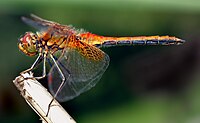
Photo from wikipedia
Different microclimates can have significant impact on the physiology of succulents that inhabit arid environments such as the Mojave Desert (California). We investigated variation in leaf physiology, morphology and anatomy… Click to show full abstract
Different microclimates can have significant impact on the physiology of succulents that inhabit arid environments such as the Mojave Desert (California). We investigated variation in leaf physiology, morphology and anatomy of two dominant Mojave Desert monocots, Yucca brevifolia (Joshua tree) and Hesperoyucca whipplei, growing along a soil water availability gradient. Stomatal conductance (gs) and leaf thickness were recorded in the field at three different sites (north-western slope, south-eastern slope, and alluvial fan) in March of 2019. We sampled leaves from three individuals per site per species and measured in the lab relative water content at the time of gs measurements, saturated water content, cuticular conductance, leaf morphological traits (leaf area and length, leaf mass per area, % loss of thickness in the field and in dried leaves), and leaf venation. We found species varied in their gs: while Y. brevifolia showed significantly higher gs in the alluvial fan than in the slopes, H. whipplei was highest in the south-eastern slope. The differences in gs did not relate to differences in leaf water content, but rather to variation in number of veins per mm2 in H. whipplei and leaf width in Y. brevifolia. Our results indicate that H. whipplei displays a higher water conservation strategy than Y. brevifolia. We discuss these differences and trends with water availability in relation to species’ plasticity in morphology and anatomy and the ecological consequences of differences in 3-dimensional venation architecture in these two species.
Journal Title: Frontiers in Plant Science
Year Published: 2020
Link to full text (if available)
Share on Social Media: Sign Up to like & get
recommendations!